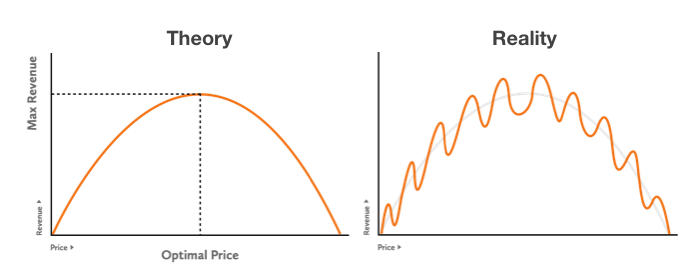The Pitfalls and Annoyances of Price Testing
In my time at Viget, I've spent considerable time thinking about how to maximize the revenue organizations generate online. Traditionally, we have helped clients more effectively sell by creating beautiful marketing websites that present product information clearly and concisely. But when it comes to optimizing total revenue, there are two parts of the formula - price and conversion rate. Through iterations of design, copywriting, and testing, we can improve conversion rates. Price, on the other hand, has typically been a constant that doesn't change through an iterative and testable process.
It has become increasingly common for us to hear from clients that they want to test their prices, which is great. We love getting deep into our clients' business challenges. But here's the problem: price testing is a prickly issue to dive into. On the surface, it would seem there should be a good way to do it. We have a number of research and testing methods available to us: surveys, focus groups, interviews, and the silver bullet, A/B testing. Surely, we can use one of these to easily and accurately test prices? Oh I wish... Unfortunately, price testing is difficult because of a few key problems that I'll run through below.
Problem #1: Consumers are irrational
In my past-life as an undergraduate economics student, the world was a beautifully rational place. At both a micro and macro level, studying traditional economics allowed me to understand why people, businesses, governments, and whole countries acted the way they did. But what has become obvious to me now is that consumer purchasing decisions are anything but rational. People are fraught with cognitive biases. They can't value products and services in absolute terms, only in relative terms. They can be easily influenced by "sales". They think $199 is a much better deal than $200.

So why is this a problem for price testing? Because in theory, we should be able to figure out consumers' demand for a product at a few different price points and then calculate optimal price to achieve maximum total revenue. In practice, there are a host of other factors that can muddy the results. I recommend reading Predictably Irrational if you want a thoughtful perspective on some of our odd decision-making tendencies.
Problem #2: You cannot simply ask people what they would pay
My UX designer heart wants to just talk to people about how much they would be willing to pay for a product or service. Sadly, even if people wanted to tell you the truth about their price sensitivity, they are incapable of accurately predicting how much they would or would not spend if presented with a real-life purchasing decision.
This effectively rules out qualitative research methods like surveys, focus groups, and interviews as accurate optimal price predictors; however, that doesn't mean they are useless. If you're thinking of launching a new product and have yet to reveal its price, you can get a general indication of whether you're in the right ballpark by using qualitative methods. In short, these methods are better for avoiding grossly misjudging an acceptable price range than they are for optimizing within a small price range.
Problem #3: Pricing is a sensitive issue
Back in 2010, President Obama's team heavily tested the effectiveness of their online donation campaigns and openly discussed the results. No one thought this was evil (and they shouldn't have). But when people get a whiff of companies such as Orbitz and Amazon experimenting with pricing, they get a little uncomfortable. It seems people are generally okay with design and copy being tested, but the thought of paying more than someone else for the same product because of a pricing test is unacceptable.
Even though most companies won't invite the attention of a major online retailer like Amazon, it can still be hard to avoid people noticing that you're actively testing different prices. If visitors access your site from multiple devices or clear their cookies, they'll possibly notice the price differences.
Does this mean you should avoid A/B testing prices? Some experts think so. Personally, I don't agree. I believe it's possible to develop A/B testing methods that address each of the problems above. In an upcoming post, I will share my thoughts for how to do this.
